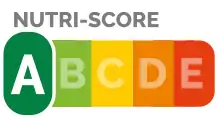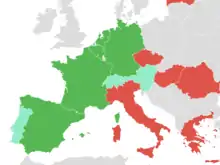Nutri-score
The Nutri-score, also known as the 5-Colour Nutrition label or 5-CNL, is a nutrition label that was selected by the French government in March 2017 to be displayed on food products after it was compared against several labels proposed by industry or retailers.[1][2][3] It relies on the computation of a nutrient profiling system derived from the United Kingdom Food Standards Agency nutrient profiling system (FSA score).[1] It has also been recommended by Belgian, Spanish, German and Dutch authorities[4][5][6][7] as well as the European Commission[8] and the World Health Organization.[3] It was created by Santé Publique France,[9] the French public health agency, based on the work of Pr. Serge Hercberg from University of Paris 13 Nord.[10]

When compared with other Front-of-Package labels, Nutri-Score emerged as the most efficient in conveying information on the nutritional quality of foods.[11]

Calculation
A Nutri-score for a particular food item is given in one of five classification letters, with 'A' being a preferable score and 'E' being a detrimental score. The calculation of the score involves only seven different parameters of nutrient information per 100g of food which are usually available on food packagings. High content of fruits and vegetables, fibers, and protein promote a preferable score, while high content of energy, sugar, saturated fatty acids, and sodium promote a detrimental score.[12]
Adoption of the Nutri-score
EU laws don't allow countries to unilaterally impose their own food labelling system, therefore they can only give recommendations.[13]
The Nutri-score has been officially recommended by health authorities in France, Germany, Belgium, Netherlands, Luxembourg and Spain.[14][15][16][17][18]
In Portugal, Switzerland, Slovenia and Austria, some food companies such as Nestlé, Auchan or Danone announced that they would use the Nutri-score although it wasn't officially recommended by the authorities.[19][20][21]

References
- Julia, Chantal; Etilé, Fabrice; Hercberg, Serge (2018). "Front-of-pack Nutri-Score labelling in France: an evidence-based policy". The Lancet Public Health. 3 (4): e164. doi:10.1016/s2468-2667(18)30009-4. ISSN 2468-2667. PMID 29483002.
- "France becomes one of the first countries in Region to recommend colour-coded front-of-pack nutrition labelling system". euro.who.int. 22 March 2017. Retrieved 7 April 2019.
- Santi, Pascale Santi (20 February 2018). "Le logo nutritionnel arrive dans les rayons des supermarchés" [The nutritional logo is now available in supermarket shelves]. Le Monde (in French). Retrieved 7 April 2019.
- Jacobs, Aline (2 April 2019). "Consommer plus sainement: le "Nutri-Score" débarque officiellement en Belgique". RTBF Info (in French). Retrieved 7 April 2019.
- Sota, Idoia (20 November 2018). "Cómo funciona NutriScore, el nuevo etiquetado de alimentos: críticas y virtudes del semáforo nutricional". El País (in Spanish). ISSN 1134-6582. Retrieved 7 April 2019.
- Morrison, Oliver (1 October 2019). "Germany plans to introduce Nutriscore: 'This is a milestone in nutrition policy'". FoodNavigator. Retrieved 4 October 2019.
- Best, Dean (29 November 2019). "Dutch government announces support for Nutri-Score". Just Food. Retrieved 1 December 2019.
- "Le gouvernement lance officiellement son étiquetage nutritionnel coloré" [Government officially launches its colourful nutrition labelling]. Ouest-France (in French). 31 October 2017. Retrieved 7 April 2019.
- "Santé publique France - Nutri-Score". www.santepubliquefrance.fr (in French). Retrieved 27 June 2019.
- "Serge Hercberg, l'homme qui a imposé le Nutri-Score". www.lefigaro.fr (in French). Retrieved 18 October 2019.
- Julia, Chantal; Pettigrew, Simone; Hercberg, Serge; Talati, Zenobia; Egnell, Manon (October 2018). "Objective Understanding of Front-of-Package Nutrition Labels: An International Comparative Experimental Study across 12 Countries". Nutrients. 10 (10): 1542. doi:10.3390/nu10101542. PMC 6213801. PMID 30340388.
- "Nutri-Score, a simple labelling system for nutritional value". nutriscore.colruytgroup.com. Retrieved 27 June 2019.
- "Petition on European food labels seeks 1m signatures". www.connexionfrance.com. Connexion France. Retrieved 1 December 2019.
- Jacobs, Aline (2 April 2019). "Consommer plus sainement: le "Nutri-Score" débarque officiellement en Belgique". RTBF Info (in French). Retrieved 7 April 2019.
- Sota, Idoia (20 November 2018). "Cómo funciona NutriScore, el nuevo etiquetado de alimentos: críticas y virtudes del semáforo nutricional". El País (in Spanish). ISSN 1134-6582. Retrieved 7 April 2019.
- Morrison, Oliver (1 October 2019). "Germany plans to introduce Nutriscore: 'This is a milestone in nutrition policy'". FoodNavigator. Retrieved 4 October 2019.
- Best, Dean (29 November 2019). "Dutch government announces support for Nutri-Score". Just Food. Retrieved 1 December 2019.
- "Luxembourg joins Nutri-Score adopters". RetailDetail. 13 February 2020.
- Revill, John (27 November 2019). "Nestle to use Nutri-Score nutrition-labeling in Europe". Reuters. Retrieved 1 December 2019.
- "Auchan Portugal Adopts Nutri-Score On Own-Brand Products". ESM: The European Supermarket Magazine. 18 October 2019. Retrieved 1 December 2019.
- Vošnjak, Anita (15 February 2019). "Danone prinaša v Slovenijo nov črkovno-barvni model označevanja živil nutri-score". Dnevnik (in Slovenian). Retrieved 1 December 2019.